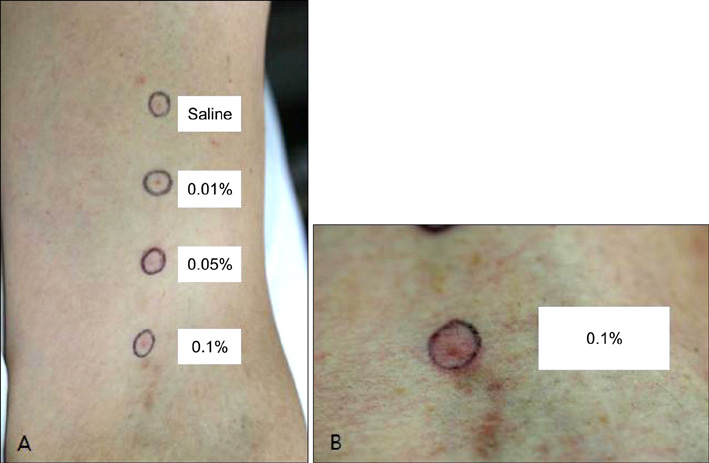Ann Dermatol.
2011 Dec;23(Suppl 3):S329-S332. 10.5021/ad.2011.23.S3.S329.
Fexofenadine-Induced Urticaria
- Affiliations
-
- 1Department of Dermatology, School of Medicine, Ewha Womans University, Seoul, Korea. hychoi@ewha.ac.kr
- KMID: 2171864
- DOI: http://doi.org/10.5021/ad.2011.23.S3.S329
Abstract
- Fexofenadine (Allegra(R) 180) is a second-generation antihistamine. It is widely used as anti-allergic drug, which suppresses various allergic reactions mediated by histamines. A few cases of H1-antihistamine-induced urticaria have been reported. Herein, we report a rare case of fexofenadine-induced urticaria which was confirmed by a prick test, oral provocation test, and flow cytometry assisted-basophil activation test.
Keyword
Figure
Cited by 3 articles
-
Drug hypersensitivity to various antihistamines with cross-reactions
Young Uck Kim, Jaechun Lee
Allergy Asthma Respir Dis. 2014;2(2):134-137. doi: 10.4168/aard.2014.2.2.134.Bepotastine-induced urticaria, cross-reactive with other antihistamines
Ju Wan Kang, Jaechun Lee
Asia Pac Allergy. 2016;6(4):253-256. doi: 10.5415/apallergy.2016.6.4.253.Recent applications of basophil activation tests in the diagnosis of drug hypersensitivity
Woo-Jung Song, Yoon-Seok Chang
Asia Pac Allergy. 2013;3(4):266-280. doi: 10.5415/apallergy.2013.3.4.266.
Reference
-
1. Lew BL, Haw CR, Lee MH. Cutaneous drug eruption from cetirizine and hydroxyzine. J Am Acad Dermatol. 2004. 50:953–956.
Article2. Stingeni L, Caraffini S, Agostinelli D, Ricci F, Lisi P. Maculopapular and urticarial eruption from cetirizine. Contact Dermatitis. 1997. 37:249–250.
Article3. Epstein E. Dermatitis due to antihistaminic agents. J Invest Dermatol. 1949. 12:151.
Article4. Barranco P, López-Serrano MC, Moreno-Ancillo A. Anaphylactic reaction due to diphenhydramine. Allergy. 1998. 53:814.
Article5. Karamfilov T, Wilmer A, Hipler UC, Wollina U. Cetirizine-induced urticarial reaction. Br J Dermatol. 1999. 140:979–980.
Article6. Demoly P, Messaad D, Benahmed S, Sahla H, Bousquet J. Hypersensitivity to H1-antihistamines. Allergy. 2000. 55:679–680.
Article7. Calista D, Schianchi S, Morri M. Urticaria induced by cetirizine. Br J Dermatol. 2001. 144:196.
Article8. Tella R, Gaig P, Bartra J, Garcia-Ortega P. Urticaria to cetirizine. J Investig Allergol Clin Immunol. 2002. 12:136–137.9. Schröter S, Damveld B, Marsch WC. Urticarial intolerance reaction to cetirizine. Clin Exp Dermatol. 2002. 27:185–187.
Article10. Kränke B, Mayr-Kanhäuser S. Urticarial reaction to the antihistamine levocetirizine dihydrochloride. Dermatology. 2005. 210:246–247.
Article11. González de Olano D, Roán Roán J, de la Hoz Caballer B, Cuevas Agustín M, Hinojosa Macías M. Urticaria induced by antihistamines. J Investig Allergol Clin Immunol. 2006. 16:144–146.12. Inomata N, Tatewaki S, Ikezawa Z. Multiple H1-antihistamine-induced urticaria. J Dermatol. 2009. 36:224–227.
Article13. Rodríguez del Río P, González-Gutiérrez ML, Sánchez-López J, Nuñez-Acevedo B, Bartolomé Alvarez JM, Martínez-Cócera C. Urticaria caused by antihistamines: report of 5 cases. J Investig Allergol Clin Immunol. 2009. 19:317–320.14. Markham A, Wagstaff AJ. Fexofenadine. Drugs. 1998. 55:269–274.
Article15. Boumiza R, Debard AL, Monneret G. The basophil activation test by flow cytometry: recent developments in clinical studies, standardization and emerging perspectives. Clin Mol Allergy. 2005. 3:9.
Article




